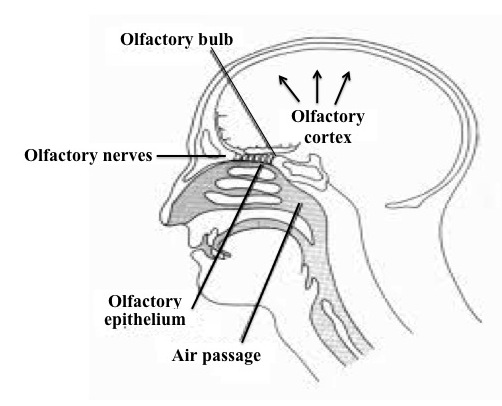The sense of smell based on the detection and identification of airborne chemicals referred to odorants. These chemical compounds are volatile, small and hydrophic, and when inhaled are transported to the olfactory epithelium (or regio olfactoria) located in the roof of the two two nasal cavities. It appears that some 95% of the nasal cavity has no olfactory function, with most of it devoted to filtering air before it reaches the lungs. The shape of the nasal cavity varies markedly among individuals, with the exit at the back being larger in women than men. Another puzzle about this part of the olfactory system is that its membrane is pigmented: it does not appear to have a function, but animals with albinism lack a sense of smell. The membrane consists of three layers of cells: olfactory receptor cells, basal cells and supporting cells. The olfactory cells are the only ones in the nervous system that are replaced on a regular basis, about every 4 to 6 weeks. Thus, cell proliferation and differentiation, as well as synaptogenesis and cell death occur throughout the life span. Olfactory receptors in the olfactory epithelium project to the olfactory glomerulus in the olfactory bulb within the olfactory tract or cranial nerve I. Here terminals of the olfactory nerve and dendrites of mitral and other cells form synapses. Axons from the mitral cells project to piriform cortex, the entorhinal cortex and the medial amygdala. The piriform cortex is implicated in odor identification, the entorhinal cortex with odor memory, and the medial amygdala with social functions such as mating and recognition of members of the same species. In humans, such recognition has been demonstrated between parents and offspring, but also between between husbands and wives. Moreover, mothers recognize the odor of their biological children, but not step children. Females tend to have a stronger sense of smell than males, and it is heightened during ovulation. Olfaction and gustation function in tandem, and together are a form of chemoreception. Olfaction adds to gustation during exhalation while smell per se happens during inhalation. While the human tongue can detect five different flavors, the olfactory system can distinguish among a vast number smells (in fact, one long-standing ‘guesstimate’ is about 10 million different smells, but recently this figure has increased to more than a trillion odors based on empirical evidence). In addition, it seems that olfaction and audition are functionally connected, at least in mice, resulting in a percept referred to as a ‘smound‘. The olfactory system has clearly differentiated structures (see figure below for some examples), but nevertheless its development has suffered from neglect relative to other sensory systems. especially at the molecular level. First gestational ages of appearance of some of the main structures are as follows:
- 5 weeks: nasal pit
- 7 weeks: nostrils
- 8 weeks: olfactory epithelial cells develop that are continuously generated throughout life
- 13 weeks: olfactory bulb that is ‘walled off’ with thin bone layer
- 28 weeks: ability to smell
